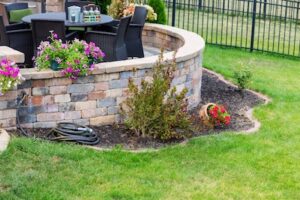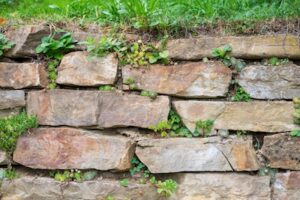DIY Retaining Wall Blocks: Tips and Tricks for Your Next Project
Welcome, DIY enthusiasts! As the summer season unfolds in all its warmth and beauty, it becomes the perfect time to engage in some exciting home improvement projects.
You may want to enhance your outdoor space, cultivate a garden, or simply create a more engaging visual impact in your yard.
If that’s the case, then constructing retaining wall blocks should be at the top of your list of projects this summer. These structures, while practical, can be a transformative addition to your garden beds or landscape.
They not only bolster the integrity of your yard but also provide an aesthetically pleasing backdrop to your outdoor setting.

Retaining Wall Blocks
Retaining wall blocks may initially seem a bit complicated to the uninitiated. However, the concept is quite straightforward once you look into it.
Retaining wall blocks are essentially sturdy blocks—commonly made from concrete, natural stone, or other materials—designed to retain or hold back soil, hence preventing it from eroding.
These walls serve two purposes. On one hand, they are functional, mitigating soil erosion and directing water flow using a proper drainage system.
On the other hand, they also contribute to the visual aesthetics of your outdoor space.
Whether they provide a vibrant base for your colorful flowers or serve as a distinctive architectural element, retaining walls significantly enhance the overall visual impact of your garden.
Planning your Project
The success of any DIY project lies in meticulous planning, and constructing a retaining wall is no exception.
The first step in the process involves determining the location of your wall.
Assess factors like soil quality, the gradient of your yard, and the purpose of the wall—whether it’s for a garden bed, landscape enhancement, or creating a flat surface for other outdoor activities.
Next comes the calculation and measurement of the wall size. These steps ensure that you have enough wall blocks and other materials for your project.
Remember, it’s better to have a little extra than to fall short mid-way through your project!
Selection of Retaining Wall Blocks
The essence of your retaining wall lies in the blocks you choose. Here, you’ll need to compare different materials and their respective advantages.
Concrete blocks are a popular choice due to their durability and ease of installation, while natural stone can provide a unique, rustic look. Several factors come into play when choosing blocks.
These include their size, shape, color, cost, and how well they blend with your overall landscape design.
Preparing the Site
Once your plan is ready and your wall blocks are chosen, it’s time to prepare your site.
This process involves clearing the area of debris or vegetation, followed by leveling the ground to establish a solid, flat surface for your wall.
Mark out your wall layout using a string line or spray paint, ensuring that your desired design, whether straight walls or curved walls, is accurately followed during wall installation.
Installation of the Retaining Wall Blocks
The actual installation of the retaining wall blocks is where the fun begins! The first row of blocks is placed directly onto the leveled ground.
A level ensures the blocks are straight, while a rubber mallet is useful for making minor adjustments. As you stack the next rows, be sure to stagger the joints for added stability.
Remember, a sturdy, safe wall is just as important as creating a visually appealing one.
Finishing Touches
Once your blocks are perfectly stacked, you can consider applying sealants or finishes.
These protective layers can help guard your wall against weathering and enhance its visual impact.
Don’t stop there, though. Landscaping around the wall with colorful flowers, plants, or other elements can add a finishing touch, tying your new wall into the overall aesthetic of your garden or yard.
Common Mistakes and How to Avoid Them
Even the most experienced DIY-ers can make mistakes, especially in complex projects like retaining walls.
Some common pitfalls include overlooking the need for a drainage solution, leveling or aligning the blocks incorrectly, or using improper materials.
Always remember to include a drainage pipe in your wall and wrap it in landscape fabric to ensure water doesn’t build up behind the wall causing damage over time.
Ensuring Safety During Construction
Never underestimate the importance of safety when building your retaining wall.
Proper personal protective equipment is a must-have, so always remember to wear protective glasses and gloves to protect yourself from unexpected mishaps.
Handling wall blocks can sometimes be heavy work, so always lift with your knees, not your back, to prevent strain.
If your wall exceeds a certain height, local building codes may require additional safety measures or even professional consultation, so be sure to look into these regulations.
Creativity and Personalization in Building Retaining Walls
Building a retaining wall doesn’t have to be a purely functional endeavor. There’s plenty of room for creativity and personalization.
Perhaps you’d like to integrate a bench into your wall or embed solar-powered lights for a beautiful night-time effect.
For those with a green thumb, designing niches in the wall for additional planting space can add a touch of green and make your wall a living part of your landscape.
Using varied wall block materials can also create a unique look—consider alternating between brick and natural stone or using colorful blocks for an eye-catching effect.
Remember, this is your project—don’t be afraid to get creative and let your personality shine through!
Maintenance Tips for Retaining Wall Blocks
Now that your wall is complete, regular maintenance is key. Like any other structure, retaining walls need care to stay in top shape.
Regular inspection for potential issues like cracks or shifting blocks, as well as cleaning to remove dirt or moss, are all part of the package.
Repairing minor issues as they arise will ensure that your wall remains both sturdy and beautiful for years to come.

Benefits of a Retaining Wall
Let’s talk about the benefits of a retaining wall.
Beyond its practical functions of soil retention and water management, a well-built retaining wall can significantly enhance the aesthetic appeal of your outdoor space.
It can structure your garden, create a backdrop for a bloom of colorful flowers, or become a visual centerpiece.
Moreover, a retaining wall can add value to your property. Whether a simple garden wall or an elaborate multi-tiered structure, it can turn an ordinary backyard into an extraordinary outdoor living space.
Start your DIY Project!
Building a retaining wall is not just about stacking blocks. It’s a creative, hands-on project that blends planning, selecting the right materials, precise installation, and regular maintenance.
With the right approach, your finished wall will serve its purpose and also enhance the aesthetic appeal of your yard, adding character and value to your property.
Through this process, you have not only upgraded your landscape but also gained knowledge, honed your skills, and likely sparked an interest in further such projects.
The steps you took were not just for creating a wall but for establishing an enduring structure that encapsulates your hard work and vision.
So, as the summer season unfolds, why not make the most of the longer days by embarking on this rewarding DIY project?
With a little effort and a lot of enthusiasm, you’ll see that building a retaining wall is one home improvement project that truly pays off.
